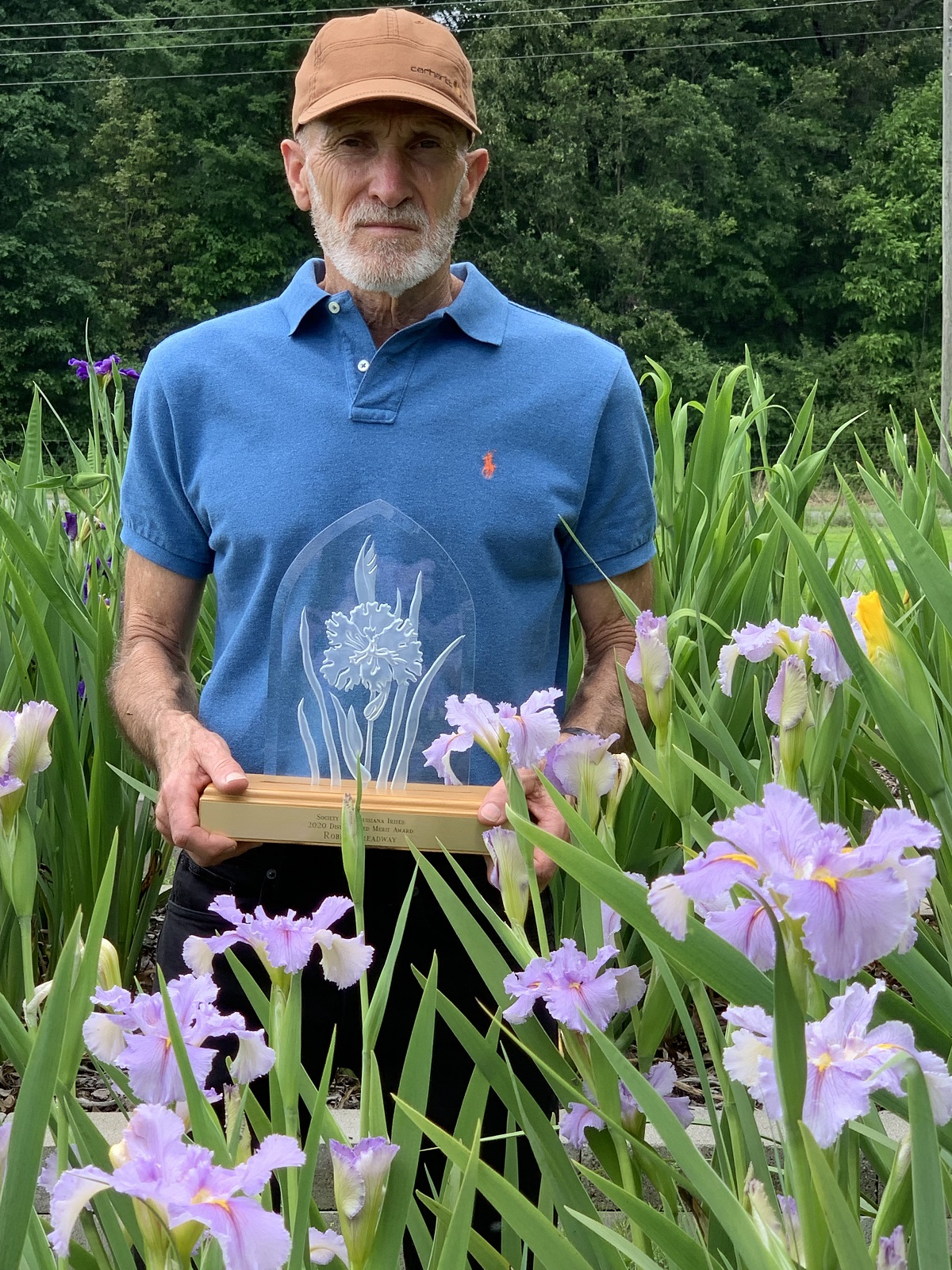One of my crosses, Professor Sigmund X chimera, as well as Joe Mertzweiller’s TD 87-34, show that diploid plants can result when the parent plant is a tetraploid. The book Haploids in Higher Plants answers some of the questions as to how this could happen. This can happen during the process of fertilization or in the first few cell divisions of the embryo.
When I first started growing the Louisiana iris, and later when an effort was made to convert them to tetraploids, everything seemed pretty straightforward. What had worked with other iris species should have given similar results with the Louisiana irises; in some case it did but in other cases the results were altogether different from what was expected.
One good example was the cross between tetraploid and diploid i.virginica. Seed were produced as easily as from the cross between two of the diploids, and the resulting seedlings were all triploids. Interploid crosses between the aril iris gave similar results only good seed were not as easy to produce. All you have to do is review results Joe Mertzweiller had with his interploid Louisiana crosses and you can see that the Louisiana irises are a law unto themselves.
My first suspicion of this carne from Professor Sigmund X chimera cross, my seedling T-89-AN. Twenty -six seeds were produced in two pods, 22 of which germinated and grew to blooming size. None showed any resemblance to Professor Sigmund and all were in the red range the same as their chimera pollen parent. They had the wide anthers and style anus of tetraploids, and the pollen that measured was in the proper range for tetraploids, but in spite of all indications of their being tetraploid only three seedlings have been produced to date. I kept thinking that they might turn out to be triploids, but one that was brought in last winter in an effort to obtain a chromosome count resulted in good clear slide showing that this particular plant was diploid. This year the blooms have been pollinated with both diploid and tetraploid pollen and both have produced pods. It will be some time before the pods are mature but maybe the number of seed produced will give some indication of what these plants really are. Note: Only one pod produced seed, 17 large ones from ‘Professor Jim’ pollen. Maybe the other plants will eventually develop some degree of fertility.
In the meantime Joe Mertzweiller sent me a start of the seedling TD 87-34. In spite of it having a tetraploid as the pod parent both of us have come to the conclusion that the plant is a diploid. Joe reached this conclusion from the results of crossing with both diploid and tetraploid pollen as well as from the morphology of the plant, and I reached the same conclusion by measuring the long axis of the stomata guard cells and by making slides for a chromosome count. While we were kicking the idea around as to how such a thing could happen I wrote Joe that somewhere I had read that there were a number of things that could cause it.
A brief mention of this was made in one of my books but it didn’t go into detail as to how it could happen, but a reference was made to another book that covered it in depth. The book is: Haploids in Higher Plants; University of Guelph; Guelph, Canada; Editor KJ. Kasha, 1974. The book covers the First International Symposium on Haploid Plants held at the University of Guelph. I obtained the book through the inter-library loan, and while some of it makes for very heavy reading it is well worth the time required.
The haploid plants that show up in interploid crosses and from crossing tetraploids with chimeras will show up as diploids. With the wide crosses, and quite possibly in some other of the interploid crosses, the male gamete can stimulate the egg and possibly other nuclei in the embryo sac into growth that will develop into embryos even if they are not fertilized. If the pod parent is tetraploid the embryos will be haploids with the diploid number of chromosomes. This can be classed either as pseudo gamy or gynogenesis and the embryo will be wholly derived from the pod parent.
On the other hand, androgenesis is the development of a haploid embryo from a male nucleus. In this case the maternal nucleus is inactivated or eliminated shortly after fertilization and only the male nucleus embryo will develop into a diploid plant with all of the chromosomes coming from the male parent.
There is another example given that is a real oddball. In this case both the male and female participate in the formation of the embryo, but the two sets of chromosomes remain as separate entities and develop their own line of growth. If the parents are very similar it might never be noticed that the plant is really a chimera with sectors of diploid growth from each tetraploid parent. Even if two different kinds of blooms were to show up on one plant it might be assumed that one was a mutation of the other. This is known as semigamy, but don’t be surprised if you can’t find the word in your dictionary.
Another way that diploid seedlings might result from interploid crosses is chromosome elimination. This is supposed to start as soon as the embryo is formed and could account for the scarcity of triploids in the Louisiana irises. This is the most likely cause of the variations in seedlings from Professor Sigmund X chimera crosses. The loss of only a few chromosomes could result in aneuploids which be the next thing to completely sterile. The elimination could also result in the loss of a complete set of chromosomes which would explain the diploid I found in the seedlings.
Twin seedlings from the same seed frequently have one that developed from normal fertilization while the other results from one of the synergid cells in the embryo sac due to the stimulation provided by the fertilization of the egg. Twins show up once in a while in the aril iris seed but I have never been able to raise both of them to maturity so the blooms could be compared. A few have been found in the Louisiana iris seeds, but in this case some portion of the seedlings have been grown together so it is unlikely that either of them will be haploids.
It should be added here that embryos can be formed from vegetative cells in the ovule rather than from the fertilized egg. This is one form of apomixis and the seed produced this way are an exact copy of the mother plant. As the seedlings produced this way are exact copies of the pod parent they will not be haploids, but as they an aberration of the normal seed production process and could account for some of the results observed it is being included.
If it hadn’t been for the odd results that showed up in 0 some of the crosses I would never have tried to dig out just what might be happening. Many of Joe Mertzweiller’s results from 2n X 4n crosses could be the results of some of the things discussed here and not due to the intervention of the bees, but there is no way the bees could cause a diploid plant to result from a tetraploid seed.
About the only way this could be pinned down is by making interploid crosses using plants that are so different from each other that there would be no way a mistake could be made I analyzing the results, and even then the crosses would have to be protected from stray pollen. This is not a hint for anyone to take on such an assignment, but it would be nice to know. As more of the members become interested in the tetraploids and start making interploid crosses and! or producing new tetraploids or chimeras through the use of chemicals this will become increasingly important to know. I made a few interploid crosses this year but these were made before the book Haploids in Higher Plants was obtained, and as a result I failed to follow my own suggestion as to the kind of crosses needed for an analysis of the seedlings produced, but maybe next year I will do better.
One wide cross that would require very little analysis to determine if both parents contributed to the seedling is a tetraploid Louisiana crossed with 1. virginica. Durio now has one of these growing in his garden and it is reported to have beautiful bloom. It would be interesting to know if it is a diploid or triploid. There are several other possible species crosses that could be tried, and probably the only reason they haven’t been done is that the Louisiana breeders see no way that crosses made with the foreign species could be an improvement over what they are already growing.
*Sam Norris was an active member of the Society for Louisiana Irises and many other horticultural societies. He was a hybridizer for over 40 years. He died in 2002. This article originally appeared in the Fall 1977 issue of the SLI Newsletter and was reprinted in the Spring 2007 issue of the Fleur de Lis, the publication of SLI.


